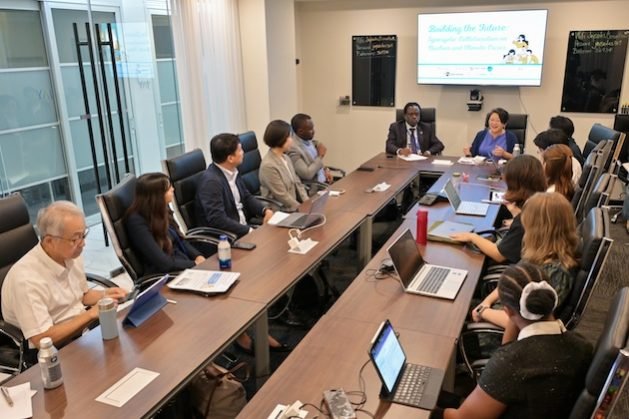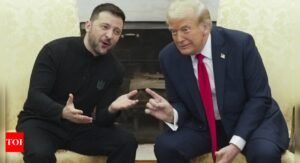Youth Pushed Motion Wanted to Deal with Nuclear and Local weather Crises — World Points


UNITED NATIONS, Sep 23 (IPS) – Driving the Summit of the Future’s core messages of worldwide solidarity and decisive motion are younger people who find themselves decided to handle the intersecting points that the world contends with right now.
Through the Summit’s Motion Days (20-21 September), it was younger individuals who led the conversations of accelerating and defining significant engagement, each on- and off-site from the United Nations Headquarters.
Not solely are they driving the dialog, however within the Pact for the Future adopted by world leaders on the United Nations on Sunday (September 22), youth and future generations are on the forefront of world leaders’ considerations, and their function was clearly outlined with the primary ever Declaration on Future Generations, with concrete steps to take account of future generations in our decision-making, together with a attainable envoy for future generations.
This features a dedication to extra “significant alternatives for younger individuals to take part within the selections that form their lives, particularly on the international degree.”
Constructing the Future: Synergetic Collaboration on Nuclear and Local weather Crises, a facet occasion whose co-organizers included Soka Gakkai Worldwide (SGI) and the Future Motion Pageant Organizing Committee, with the assist of the United Nations College (UNU) and the United Nations Data Centre (UNIC), introduced collectively younger activists to debate the intersection between two completely different crises and what is going to outline significant youth engagement.
Kaoru Nemoto, the Director Normal of UNIC in Tokyo, noticed that it was “ground-breaking” to see the agenda of the Summit’s Motion Days largely led and arranged by youth individuals, as signified by nearly all of seats within the Normal Meeting Corridor being stuffed by younger activists.

“There may be an undercurrent, a typical message, that the youth could make this world a greater place to dwell,” mentioned Nemoto. “It doesn’t matter what agenda you might be engaged on, be it local weather change, nuclear disarmament, preventing inequality… youth points are cross-cutting, very robust cross-cutting points throughout the board.”
Nemoto additional added that the United Nations must do far more to have interaction youth for significant participation. This might imply permitting youth to seek the advice of in decision-making and to be in positions of management. Youth presence can’t be decreased to tokenism.
The local weather and nuclear crises are existential threats which are deeply related, mentioned Dr. Tshilidzi Marwala, the rector of the United Nations College. Local weather instability fuels the components that result in battle and displacement. Battle, comparable to what is going on in Sudan, Israel, Palestine, and Ukraine, will increase the danger of nuclear escalation. As leaders within the current day sort out the problems, Marwala referred to as on the youth to proceed elevating their voices and to carry these powers accountable.
Marwala famous that the United Nations College could be dedicated to “realizing significant participation” in all events. For younger individuals, whereas they’re motivated and show a take care of deeper social points, they face challenges in having their voices heard or in feeling galvanized to take motion. Marwala famous that it was essential to succeed in out to these younger people who find themselves both not concerned or really feel discouraged from getting concerned in political work and activism.
Chief among the many Summit of the Future’s agenda is growing youth participation in decision-making processes. It has lengthy been acknowledged that younger activists and civil society actors drive larger societal change and are motivated to behave in direction of advanced points. But they continuously face challenges in taking part in policymaking that may form their nations’ positions.
Amongst these challenges are illustration in political areas. Throughout the context of Japan, younger individuals are underrepresented in native and nationwide politics. As Luna Serigano, an advocate from the Japan Youth Council, shared through the occasion, there’s a wider perception amongst younger voters in Japan that their voices will go unheard by authorities.
That is indicated in voter turnout, which reveals that solely 37 % of voters are of their 20s, and solely 54 % of voters imagine that their votes matter. Against this, 71 % of individuals of their 70s voted in elections. Individuals of their 30s or youthful account for simply 1 % of pros serving in authorities councils and boards. The Japan Youth Council is presently advocating for energetic youth participation within the nation’s local weather change coverage by calling for younger individuals to be instantly concerned as committee members to work on a brand new power plan for the approaching yr.
Yuuki Tokuda, a co-founder of GeNuine, a Japan-based NGO that explores nuclear points by way of a gender perspective, shared that younger individuals are out of decision-making areas. Though their voices could also be heard, it isn’t sufficient. As she advised IPS, the local weather and nuclear crises are on the minds of younger individuals in Japan. And whereas they’ve concepts on what could possibly be executed, they aren’t knowledgeable on tips on how to act.
There may be some hope for growing participation. Tokuda shared inside policymakers on nuclear points, of which 30 % embrace girls, have begun to have interaction with younger individuals in these discussions.
“It’s time to reconstruct programs in order that youth can meaningfully take part in these processes,” mentioned Tokuda. “We’d like extra intergenerational participation to be able to work in direction of the ban of nuclear weapons and the local weather disaster.”
Through the occasion, what significant youth engagement ought to appear to be was mentioned. It was acknowledged that efforts have gone in direction of giving an area to the views of younger individuals. Together with younger individuals within the discussions is a essential step. It was advised that course ought to shift in direction of guaranteeing that younger individuals have the authority to take the motion wanted to resolve intersecting, advanced points. In any other case, the inclusion is meaningless.
“The longer term-oriented youth is extra wanted than ever to sort out the challenges in constructing and sustaining peace,” mentioned Mitsuo Nishikata of SGI.
“As a youth-driven initiative comparable to what the Future Motion Pageant demonstrates, youth solidarity can stand as a place to begin for resolving and passing points.”
Subsequent yr (2025) will mark 80 years because the finish of World Warfare II and the Hiroshima-Nagasaki atomic bombings. Nishikata identified that this will likely be a time for essential alternatives to advance the discussions on nuclear disarmament and local weather motion, forward of the Third Assembly of State Events on the Treaty on the Prohibition of Nuclear Weapons and the 30th UN Local weather Convention (COP30).
“We are going to proceed to unite in our need for peace, sharing the duty for future generations and increasing grassroots actions in Japan and globally.
Different commitments for the Pact for the Future included the primary multilateral recommitment to nuclear disarmament in additional than a decade, with a transparent dedication to the aim of completely eliminating nuclear weapons.
It additionally pledged reform of the United Nations Safety Council because the Nineteen Sixties, with plans to enhance the effectiveness and representativeness of the Council, together with by redressing the historic underrepresentation of Africa as a precedence.
The pact has at its core a dedication to “turbo-charge” implementation of the Sustainable Growth Targets (SDGs), together with the reform of the worldwide monetary structure in order that it higher represents and serves growing nations.
“We can’t construct a future that’s appropriate for our grandchildren with a system that our grandparents created,” because the Secretary-Normal António Guterres said.
This text is dropped at you by IPS Noram in collaboration with INPS Japan and Soka Gakkai Worldwide in consultative standing with ECOSOC.
IPS UN Bureau Report
Observe @IPSNewsUNBureau
Observe IPS Information UN Bureau on Instagram
© Inter Press Service (2024) — All Rights ReservedAuthentic supply: Inter Press Service






